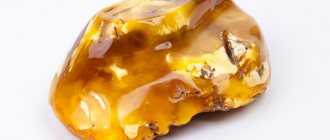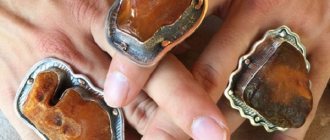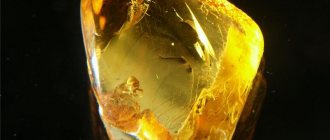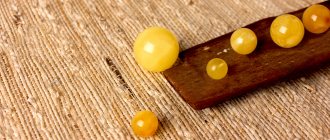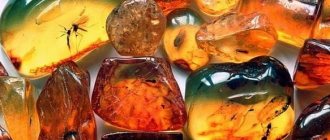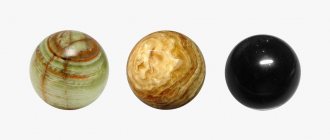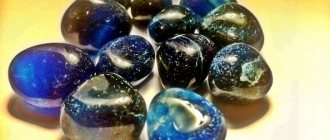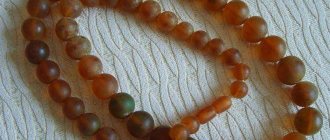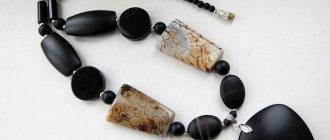Amber is a fossilized resin that stores the energy of the earth and absorbs the power of the sun. That is why this gem has long been credited with magical and healing properties, thanks to which the stone helped with pain, had a calming and at the same time powerful energy effect, and protected its owner from the evil eye.
Currently, medicinal amber is no less popular, because its properties have been proven over the years, and its unique beauty attracts the eye and gives confidence to the owner. In addition, the advantage of this decoration is the combination of many useful properties with affordable prices.
Where is amber used?
Amber was used in different ways in different countries and at different times. In Ancient Egypt, stone became the ideal material for creating incense burners. They believed that it had the necessary properties, so they used it for embalming.
In Rome, amber was widely used to create various luxury items, including amulets and jewelry.
Amber was no less actively used as a healing agent; even in ancient medical chronicles there are comments on this matter. Many healers in their works recommended amber for mental disorders, as incense and potions.
The most common use of the stone is jewelry. To this day, many people use stone as a wonderful addition to a product, but the amber room is considered the most unique work.
Colors and varieties
The widespread belief that amber comes in purely yellow shades is fundamentally wrong - modern experts identify as many as four hundred different colors. Yellow and orange species are simply much more common, which is why all these poetic epithets about the “gifts of the Sun” refer to them.
At the same time, you need to understand that the relatively high prevalence reduces the demand for such a stone - a gem of any atypical shade is more valuable. At the same time, it would be foolish to evaluate a piece of amber purely by its color - the cost is determined by its size, the skill of processing, and, especially, the presence of inclusions.
The three most popular colors include milky white amber, but it is interesting that the substance itself is not white. This color is only a visual effect, it’s just that in the thickness of the yellowish tint there are abundant inclusions of air and water bubbles, which give the stone a whitish color.
In some specimens, these opacities are detected only on the outside, since there is practically no transparency - such a specimen is called landscape. It doesn’t always look really beautiful, but sometimes a properly polished bead greatly resembles one of the planets of the solar system.
If you want to find a truly exclusive specimen, focus on amber in which a certain prehistoric insect is frozen. It is quite difficult to obtain such a specimen, because it is very rare, and scientists, museums and the powers that be are hunting for it.
What is amber
The stone is an ornamental material with a translucent or transparent structure of sufficient hardness. The color can vary from light yellow to dark orange or even ivory.
The most expensive stone is always transparent and light in color; inclusions such as insects, plant seeds and many other things that could have entered the stone 150 million years ago are often valued.
Philologists say that the word “amber” comes from “Gintars”, which in Lithuanian means protector from illness. There are many other names for the stone, for example, ambrite, ambrosine, gift of the sun and others.
Originals and fakes - features of real cabochons
People began to imitate natural precious stones a very long time ago. Counterfeits are made from glass, ceramics, plastics, polystyrene and polyesters. Sometimes a little crushed solar gems are added to the artificial base - this is how bernite, gedanite, and glossite are obtained. Sometimes “immature” resins (burmite, rumenite, copal) are passed off as high-quality cabochons, the main disadvantage of which is their high softness. The surface of such a nugget can be damaged by simply pressing on it with your fingernail! But ambroid (amber chips, to save raw materials, pressed into a single mass using heat and pressure) is not considered a fake, although its appearance is inferior to the beauty of natural stones.
All of the surrogates listed above (except ambroid) do not have healing properties. Therefore, if you want to purchase accessories made from polished cabochons or buy raw amber, you need to carefully study each gem. How can you identify real hardened resin? Here are some easy to implement methods:
- if you rub a gemstone on fur, wool or silk, small fibers of fabric, hairs and even pieces of paper will stick to its electrified surface;
- Place the cabochon in a saturated saline solution (8-10 tablespoons of table salt per glass of water). Since the density of natural amber is only 1.05-1.09 g/cm3, it will float to the top;
- run a knife or needle over the gem. Natural hardened resin will crumble into small fragments, and plastic imitations will produce elastic shavings;
- sun stones quickly heat up in the hand, emitting a pleasant resinous aroma;
- In real cabochons there are many inclusions - particles of bark, leaves, flowers that got into the hardening resin. Sometimes there are even inclusions - insects, spiders, lizards. In addition, air bubbles are often visible in amber: in naturally occurring stones they are impeccably round, while in ambroid they are elongated vertically.
Compound
This is a high molecular weight compound that contains a large amount of succinic acid. Most of amber contains carbon, some hydrogen and oxygen. Depending on where the stone deposit is located, the quantity and quality of its components may vary. In addition to standard elements, the chemical composition may contain silicon, nitrogen and other impurities.
Baltic amber, which is valued throughout the world, contains many additional impurities. These are manganese, aluminum, copper, sodium and others.
How is stone mined?
From the first day that amber began to be used by humans, it was mined manually. on beaches or shallows, the gem was simply collected for further processing.
After the advent of a large number of hand tools, stone extraction began to be carried out using nets. Equipped with a long handle, they helped to pull out seaweed with stones entangled in it. A little later, the mining method became more advanced and stones simply began to be scooped up from the bottom of the sea using scrapers and tongs.
It is precisely because amber floats in salt water that people came up with the idea of harrowing the coastal zone. After this procedure, a stone surfaced to the surface and was subsequently assembled by hand.
Since the end of the 19th century, amber began to be mined in mine workings. This method has become more expedient and profitable.
Recommendations for caring for tourmaline products
Under no circumstances should products be soaked in water for a long time. There is also no need to use detergents, soaps, or bleaches for washing.
This will cause loss of functional properties of the product. You should only use tourmaline soap.
We recommend light washing of products in clean water (washing time within 5 minutes) at a water temperature of up to 40 degrees Celsius, or washing under running water.
It is advisable to place the products in the sun every 5-7 days, or, in the absence of sun, near heating devices for 2-3 hours. This is necessary to enhance infrared radiation.
Medicinal properties
Science has already been able to prove in practice that amber has healing properties. Succinic acid is a powerful biostimulant.
Since ancient times, the stone has been used to treat the throat, eyesight, thyroid gland, and arthritis.
Lithotherapists actively promote treatment with amber, claiming that it can relieve headaches, improve heart function, and activate metabolism.
Sore throat, skin diseases, joints, kidneys and intestines can also be improved if you choose amber as a treatment.
In addition to all that has been said, the stone helps restore the nervous system, it stabilizes the general condition of the body and returns strength to it.
You can use the unique qualities of amber in the complex treatment of various tumors, including malignant ones.
In medical practice, not only products from this stone are used, but also crumbs, tinctures and various kinds of mixtures. People who prefer traditional medicine are sure that through the use of amber they can restore their body to its former youth.
Field
At the dawn of civilization, the main European source of amber was a deposit in what is now Denmark, but it was exhausted in ancient times. Already in the ancient Roman period, the main region for the extraction of amber gems could already be considered the Amber Coast in the Baltic States, located today in the Kaliningrad region of Russia, as well as in neighboring Lithuania and Latvia. It is generally accepted that today up to 90% of all deposits of this stone are concentrated here, and there is also a one-of-a-kind amber plant that mines such gems.
There is also quite a lot of amber in Ukrainian Polesie. Local Rivne amber is also quite widely known. The local deposits belong to the Baltic-Dnieper subprovince of the Euro-Asian amber-bearing province, so the “gifts of the Sun” here are echoes of the neighboring Baltic states.
Amber in magic
Not only healing, but also magical properties have made amber such a sought-after stone. A hundred years ago, amber was processed to create unique and very powerful amulets. The produced incense was used during rituals, believing that they created a special atmosphere.
Most magicians are inclined to believe that spirits live in frozen pieces of resin that you can talk to.
In the magical world, it is believed that amber can protect its owner from damage and the evil eye, and attract good luck and the attention of the necessary people. It is able to enhance human intuition and give courage.
Since ancient times, the presence of a stone in a house was a good protection against fire, and amber itself lured happiness, peace and tranquility into the family.
Uses of amber
All varieties of amber have their uses. The best specimens are used in jewelry and applied arts. Jewelry, paintings, and any other household items are made from amber. Amber chips are actively used.
In pharmaceuticals, as mentioned above, amber has also found its use. The succinic acid produced is also used in agriculture, it helps plant growth and increases the amount of harvest.
Strange as it may seem, stone is also used in the chemical industry. Melted amber is used in rosin, enamel and varnish. Wood and metal are treated with such compounds.
Possessing excellent electrical insulating properties, amber has found its application in technology, where it is used as an insulator.
Legends about the stone
Humanity has come up with quite a few legends about the stone; one of them says that amber is pieces of the palace of the divine Jurata, who was punished by her father for her love for a mortal fisherman. At first she lived in an amber palace at the bottom of the sea, but when she saw the sailor she could not help but fall in love and take him with her.
A storm arose, reminding the girl that the gods cannot love mortals, but she did not pay attention to it, and then Perkūnas the Thunderer threw lightning straight into the palace, breaking it into small particles, which are still washed ashore by the sea wave today. Yurate, together with the fisherman, was carried ashore and died. Since then, girls, collecting amber, remember pure and beautiful love, and when the sea is rough, they say that it is Yurate who cries for her lover.
Interesting Facts
There are many interesting facts about amber that have accumulated over the rich history of its use in human life. For example, in the thirteenth century, the Pope’s doctor created an elixir of youth based on this stone, and Luther always had amber with him to prevent sand and stones from appearing in the kidneys.
One of the most valuable in our time is a stone with insects inside. Previously, such a specimen would cost hundreds of swords or sixty daggers.
At the end of the nineteenth century, out of fear of getting cancer from smoking, all smoking accessories began to be made from this stone.
The triumph of the use of amber was the room in the Royal Palace, which anyone can visit today. Once indoors, you begin to understand how diverse the color palette nature offers in the form of amber. When entering a room, there is a feeling of another space, which is difficult to get rid of long after leaving it.
Tourmaline: magical properties of the stone
The properties of tourmaline depend on its color:
- Black. It sharpens perception, attracts inspiration, drives away self-doubt, and neutralizes negative emotions. Perfect for representatives of creative professions. Among the zodiac signs, it is best suited for power-hungry Leos and restless Scorpios.
- Pink. Allows the owner to remain young at heart regardless of age, helps to love himself and attract the love of the opposite sex. Suitable for Capricorns.
- Red. A talisman for creative individuals, helps to harmonize relationships in couples. Recommended for Aries.
- Watermelon (red-white-green). It awakens harmony with the world and compassion in a person, helps to heal mental wounds, and teaches the owner to rejoice under any circumstances. Will help Virgos, Geminis, Capricorns.
- Green. It is considered one of the most powerful stones of the heart chakra and a protector from any kind of negative influences. Such a talisman can be chosen by Gemini, Libra and Aquarius.
- Blue. Helps the owner develop spiritual qualities. Taurus, Sagittarius and Aquarius should take a closer look at blue tourmaline.
But you should not wear jewelry with sherl all the time - it is believed that it absorbs a lot of negativity, so it should be given a rest.
